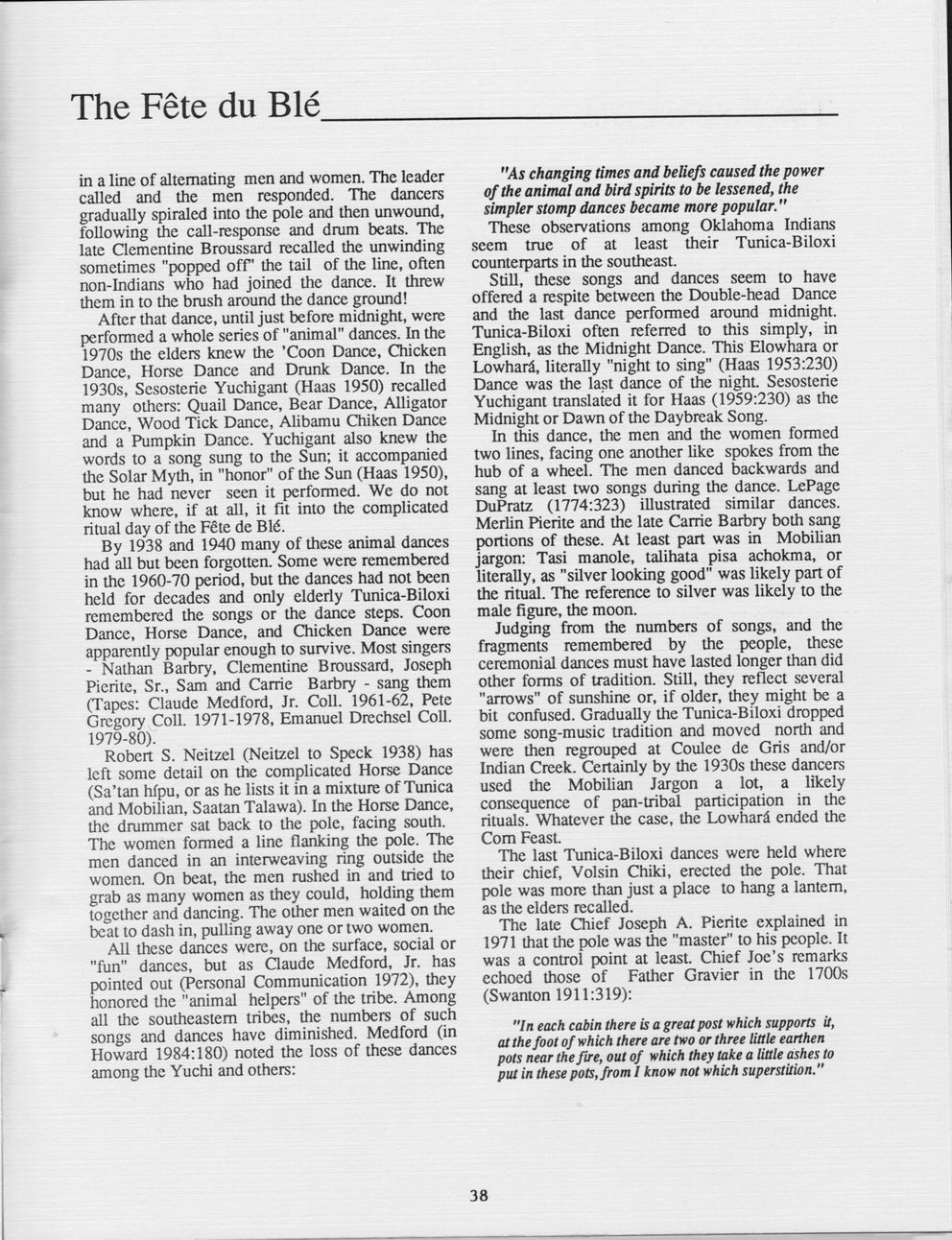This text was obtained via automated optical character recognition.
It has not been edited and may therefore contain several errors.
The Fete du Ble in a line of alternating men and women. The leader called and the men responded. The dancers gradually spiraled into the pole and then unwound, following the call-response and drum beats. The late Clementine Broussard recalled the unwinding sometimes "popped off’ the tail of the line, often non-Indians who had joined the dance. It threw them in to the brush around the dance ground! After that dance, until just before midnight, were performed a whole series of "animal" dances. In the 1970s the elders knew the ’Coon Dance, Chicken Dance, Horse Dance and Drunk Dance. In the 1930s, Sesosterie Yuchigant (Haas 1950) recalled many others: Quail Dance, Bear Dance, Alligator Dance, Wood Tick Dance, Alibamu Chiken Dance and a Pumpkin Dance. Yuchigant also knew the words to a song sung to the Sun; it accompanied the Solar Myth, in "honor" of the Sun (Haas 1950), but he had never seen it performed. We do not know where, if at all, it fit into the complicated ritual day of the Fete de B16. By 1938 and 1940 many of these animal dances had all but been forgotten. Some were remembered in the 1960-70 period, but the dances had not been held for decades and only elderly Tunica-Biloxi remembered the songs or the dance steps. Coon Dance, Horse Dance, and Chicken Dance were apparently popular enough to survive. Most singers - Nathan Barbry, Clementine Broussard, Joseph Pierite, Sr., Sam and Carrie Barbry - sang them (Tapes: Claude Medford, Jr. Coll. 1961-62, Pete Gregory Coll. 1971-1978, Emanuel Drechsel Coll. 1979-80). Robert S. Neitzel (Neitzel to Speck 1938) has left some detail on the complicated Horse Dance (Sa’tan hfpu, or as he lists it in a mixture of Tunica and Mobilian, Saatan Talawa). In the Horse Dance, the drummer sat back to the pole, facing south. The women formed a line flanking the pole. The men danced in an interweaving ring outside the women. On beat, the men rushed in and tried to grab as many women as they could, holding them together and dancing. The other men waited on the beat to dash in, pulling away one or two women. All these dances were, on the surface, social or "fun" dances, but as Claude Medford, Jr. has pointed out (Personal Communication 1972), they honored the "animal helpers" of the tribe. Among all the southeastern tribes, the numbers of such songs and dances have diminished. Medford (in Howard 1984:180) noted the loss of these dances among the Yuchi and others: "As changing times and beliefs caused the power of the animal and bird spirits to be lessened, the simpler stomp dances became more popular." These observations among Oklahoma Indians seem true of at least their Tunica-Biloxi counterparts in the southeast. Still, these songs and dances seem to have offered a respite between the Double-head Dance and the last dance performed around midnight. Tunica-Biloxi often referred to this simply, in English, as the Midnight Dance. This Elowhara or LowharS, literally "night to sing” (Haas 1953:230) Dance was the last dance of the night. Sesosterie Yuchigant translated it for Haas (1959:230) as the Midnight or Dawn of the Daybreak Song. In this dance, the men and the women formed two lines, facing one another like spokes from the hub of a wheel. The men danced backwards and sang at least two songs during the dance. LePage DuPratz (1774:323) illustrated similar dances. Merlin Pierite and the late Carrie Barbry both sang portions of these. At least part was in Mobilian jargon: Tasi manole, talihata pisa achokma, or literally, as "silver looking good” was likely part of the ritual. The reference to silver was likely to the male figure, the moon. Judging from the numbers of songs, and the fragments remembered by the people, these ceremonial dances must have lasted longer than did other forms of tradition. Still, they reflect several "arrows" of sunshine or, if older, they might be a bit confused. Gradually the Tunica-Biloxi dropped some song-music tradition and moved north and were then regrouped at Coulee de Gris and/or Indian Creek. Certainly by the 1930s these dancers used the Mobilian Jargon a lot, a likely consequence of pan-tribal participation in the rituals. Whatever the case, the Lowhard ended the Com Feast. The last Tunica-Biloxi dances were held where their chief, Volsin Chiki, erected the pole. That pole was more than just a place to hang a lantern, as the elders recalled. The late Chief Joseph A. Pierite explained in 1971 that the pole was the "master" to his people. It was a control point at least. Chief Joe’s remarks echoed those of Father Gravier in the 1700s (Swanton 1911:319): "In each cabin there is a great post which supports it, at the foot of which there are two or three little earthen pots near the fire, out of which they take a little ashes to put in these pots, from I know not which superstition." 38

Native Americans The-Tunica-Biloxi-Tribe-its-Culture-and-People-(47)